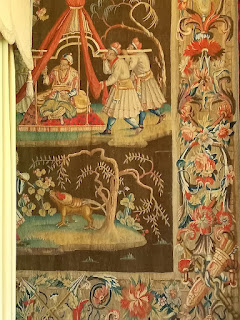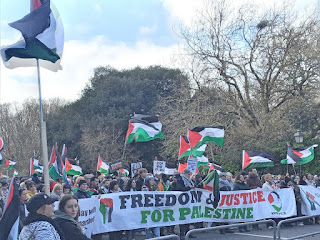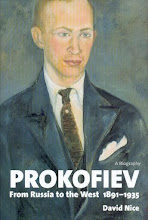After a worrying January during which my old mum's fate hung in the balance, and with her happily reinstalled back in her excellent nursing home, I've been able to join J in what is now his city for longer. And all the more blissfully since he's found a dream palace in the air on the same side of Merrion Square where Oscar Wilde grew up. Is there a better view in Dublin? I doubt it. On a good day the Dublin Hills/Wicklow Mountains can be seen. Not so on 1 March, when we woke to find snow everywhere.
It lasted a day, not before it made an excursion to a noodle bar down the hill alongside the Maternity Hospital a perilous ten minutes. This time, though, spring was beginning and the hills had re-emerged. The uncommon narcissi taking the place of St David's Day daffodils were brought by dinner guest Maev and smelled heavenly.
My first visit of 2024 embraced so much that shows how healthy the Irish classical music scene is right now: Spanish night from the National Symphony of Ireland complete with flamenco performer, a pioneering weekend of string quartets and quite simply the most moving and high-level performance of Bach's St Matthew Passion I've ever heard. That was a date on which so much depended, as was my return to catch the last performance of Irish National Opera's triumphant Salome. I also saw half a play, which I would have written about for The Arts Desk had I liked it better and stayed. Gratitude, though, for our untimely departure leading to the serendipitous discovery of the best Indian food we've eaten since the last India trip, and the best film I've seen so far this year (and for a change I've seen quite a few). Love Life was the Monday offering at the Pavilion, Dún Laoghaire, and my friend Catherine, who goes when she can, asked me along on J's bridge night.
This unpredictable masterpiece, a superb piece of story-telling from Japanese director and screenwriter Kôji Fukada, constantly wrong-foots the viewer. The typical (I'm told) mix of low-key politeness and sudden bursts of anger accounts for part of the surprise, but I didn't expect to end up laughing so much in the later stages of the film. To disclose anything about the plot would be to spoil the fun; let's just say these three actors are superb.
The pace is surely dictated by the director as scriptwriter; the same can be said for Bong Joon Ho's Parasite, which we finally saw on the home movie screen here in Dublin last night: similarly surprising in its changes of direction. Thank you, Catherine. She's also been a willing chauffeur for excursions. After the Powerscourt revelations, we headed in February for Russborough House in West Wicklow.
The Georgian house, its two wings making it the longest in Ireland, was designed by Richard Cassels/Castle for Joseph Leeson, First Earl of Milltown, and built between 1741 and 1755. If 'Milltown' rings a bell, it may be because of the Milltown Collection now lodged in the National Gallery of Ireland. The master brewer acquired some great art on his two Grand Tours. A few treasures remain, not least the well-framed seasonal seascapes of Vernet in the Drawing Room - two of them seen here flanking what (disappointingly) turns out to be a copy of Guercino's Triumph of David.
The stucco work is original; its apogee is on the grand staircase, probably the work of the Lanfranchini brothers.
The next stage in the house's evolution was the arrival of the Beits, heirs to a diamond mine fortune. Alfred the younger married a Mitford, Clementine, and since the house kept being burgled - notably through the agency of Rose Dugdale, who died only yesterday, heiress turned IRA member (the film on the heist is reviewed here on The Arts Desk- the larger part of the Beit collection also went to the National Gallery of Ireland. It includes masterpieces by Vermeer, Velazquez and Goya. All the pictures stolen over time bar two were recovered. There are some fine relics still at Russborough, including a pair of tapestries with Indian-Chinese fantasies on them. Sadly one is part concealed by a four-poster bed, but what you can see of it is fine.
Since the inhabitants died childless, a foundation protects the house's status. The basement rooms, though dominated by a shop, include a cinema showing Beit's movies of his world travels and 3D photos you can see through what we used to call 'View Masters' in another room.
It was pouring with rain on our first visit, and since I left a fine green scarf behind, on this trip Catherine indulged me by driving back to Russborough. We were able to do what the downpour had prevented - walk a circuit to the west of the house, including a walled garden and, eventually, a fine view of the house.
Then we took a fine route over the nearby mountain from Hollywood - it has its own joke signing on the hillside - and stopped briefly at the Wicklow Gap, c. 475m, with meadow pipits and siskins for company,
before heading down to Glendalough. I'd promised to come here with J, so this was just a preliminary circuit around a small part of the monastery 'city' attendant on the presence of St Kevin here. Probably not his fault (because no doubt misogynistic hokum) if, alongside the lovely idea of a blackbird's eggs hatching on his long-outstretched palm, the most famous thing about him is his fundamentalist murder of 'temptress' Kitty. Catherine sang me the mocking folksong, with the key verses being the last two:
He gave the poor creature a shake
Oh, I wish that the garda had caught him
He threw her right into the lake
And of course she sank down to the bottom
It is rumoured from that very day
Kathleen’s ghost can be seen on the river
And the saint never raised up his hand
For he died of the right kind of fever
I give these because you may not be able to make out the words in the Dubliners' splendid rendition.
Anyway, here's Catherine on the bridge over a river in full spate.
The path up through the woods is magical, with mossy beech trees to the left,
but we'll continue to the upper lake, and Kevin's retreat, on another visit. Here we simply circled the medieval buildings in the cemetery, namely the saint's church,
the atmospheric ruin of the Cathedral,
and the Round Tower.
The site has the potential for peace and quiet, but there were quite a few American tour groups, here for St Patrick's Day. I imagine we'll return on a summer's evening, and maybe bathe in the upper lake.
Meanwhile, we headed for a Sunday morning service to catch good singing on the saint's big day. Trinity College Chapel was closed, so it made sense to walk up past the crowds awaiting the big procession to Christ Church Cathedral.
The service included Victoria's Missa o quam gloriosum and Tallis's 'Verily I say unto you'; the choir is first-rate. While I sat trying to hear the words of a very good sermon about Dublin's problems from Richard Carson of Dublin city centre's Aids Care Education and Training, I couldn't help admiring the tiles old and more recent.
J, however, was nowhere to be seen. For some reason still obscure to me, he'd doubled back and headed down to St Patrick's Cathedral, which was certainly inviting from the top of the thoroughfare. These two shots lookng both ways.
The street parades also took me back to my first full day on the first visit of the year, when thousands of Ukrainians paraded below the windows to mark two years of Putler's awful invasion.
On Monday, we went to the Quaker Cemetery outside Blackrock to remember our dear friends Beulah and Thomas Bewley. All gravestones are identical; typical of Quaker equaity. More on Beulah's funeral here; J was present in Dublin for Thomas's ceremonial. We always felt so welcome by both of them, and I was touched that in the early stages of dementia, when I visited her in Victoria, she said, 'well, you two are the musical part of the family'.
After that, we had lunch in Blackrock with friend Nancye, then walked out over Dublin bay. Greeting us immediately, or rather on their way from the sea to a rock pool for a communal swim, were a group of brent geese (the term, incidentally. comes from 'burnt' - the heads look as if they've been dipped in oil).
Ritual swiftly concluded, they headed back to sea.
Reading up on these thousands (or tens of thousands) of overwinterers here from their Arctic breeding grounds in Richard Nairn's Wild Shores: The Magic of Ireland's Coastline, I learnt that they favour North Bull Island, that natural phenomenon created by the construction of a retaining wall on the north side of the Liffey from Clontarf to the sea in 1820 (Captain Bligh of Bounty fame had conducted the initial survey). The walk from Clontarf Junction Dart station along the esplanade and over the wooden bridge to the island, and back via the main bridge further north to Raheny station is an abiding memory from late 2022, and given a sunny start on Friday, I decided to do it again. I didn't have to walk far to catch a group of brent geese
who flew up when I got closer.
A fierce wind was behind me as I walked along the wall, admiring seagulls coasting on it, and though the tide was in, there's always saltmarsh the other side of the wooden bridge to North Bull Island to observe the usual redshanks, curlews, oystercatchers and (here, mostly, not in closeup because my treasured Lumix with its excellent Leica Zoom, has packed up) turnstones.
Essential lunch at the splendid cafe close to the beach, where windshields made sitting outside and conversing with the starlings possible, set me up for the rest of the walk - along the land behind the dunes
to the beach. I'm not sure where it becomes Dollymount Strand, but this time I kept walking along the sands until the route in to the road (2022's marshy wander was wet and a bit confusing, but rich in small birds). Showers threatened but didn't really get started, and rainbows were a reward
Skylarks twittered, later linnets, until my luck gave out crossing the road bridge, and I got drenched in a sudden squall. Soon dried out in the returning sun on the way to the Dart station, though.
My procrastination in getting this post sorted yields another beauty from yesterday (Saturday), the grounds of Farmleigh at the west end of Phoenix Park, described as 'the official state guesthouse with a distinguished Guinness heritage'. The gardens are free to wander, and the magnolia walk was in full spate. Praise be to our friend (first) and driver (second) Séamus for bringing us here.
Within the walled garden, a cherry tree in full spate (not labelled, perhaps not as low as my favourite the Yoshino, but just as spectacular) outclasses even the magnolias).
The herbaceous borders will be spectacular later on - plenty of peony promise - and there will be wisteria flowering around the front door of the not especially distinguished house (eclipsing a Georgian original), but the blossom is good here too.
The Gallery (generously free, too) currently has two exhibitions going, one on Sir William Orpen (which didn't interest me much, my loss, no doubt) and the other devoted to the extraordinary photographs of his second cousin Goddard Orpen (which absolutely did). Do glass plate negatives - these ones recently discovered and curated by the Monksgrange Archives - give an atmosphere and depth to pictures? This seemed to bear testament.
All the portraits are excellent, but J and I were especially struck by a quartet which included two very different men - Philip Conran of Corrageen Lane and father-in-law Edward Richards, sporting a home-made uniform (he was a lifelong supporter of the Dress Reform Movement).
On our return to the centre of Dublin, we coincided with a march for Palestine. Though I abhor what's so obviously a genocide taking place on Israel's part, I don't feel entirely comfortable with the Palestinian flag or the 'from the river to the sea' proclamation; both can carry a message denying Israel's right to exist. But this protest, which I caught with speakers and singers on the south side of St Stephen's Green, seemed to be doing all the right things. And Ireland has a special affinity with Palestine, for obvious reasons.
Today we're back to city swanning and a St John Passion. By way of conclusion, I have to draw your attention to the infinite variety of Wednesday's WAKE, which I'm not strictly qualified to write about, but I did, for The Arts Desk, and a few snaps from a related event I mention at greater length in that review, the RTÉ Radio 1 Folk Awards - notable for its diversity, the huge number of young people taking up traditional instruments, and the easy predominance of Irish language which the audience understood (as J said, Kerry was in the house).
I had put up a TV highlights link, but Howard Lane in a comment below says it's no longer available. The radio link still is at the time of writing - try here - and that has the courageous rant against the genocide in Gaza. I loved the venue, Vicar Street in the Liberties, and was happy with a 0.0 Guinness, now available, they say, on tap in over 1000 pubs and bars (a Guinness aficionado I know says it's better than the original...)
Sláinte!

























































